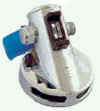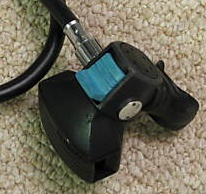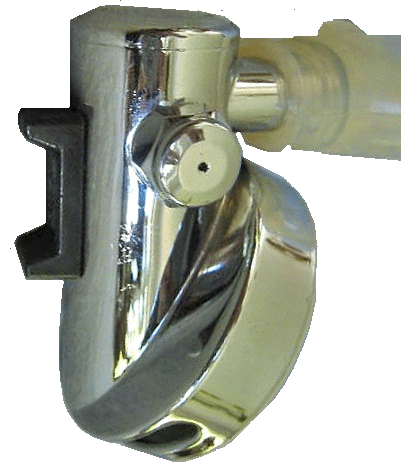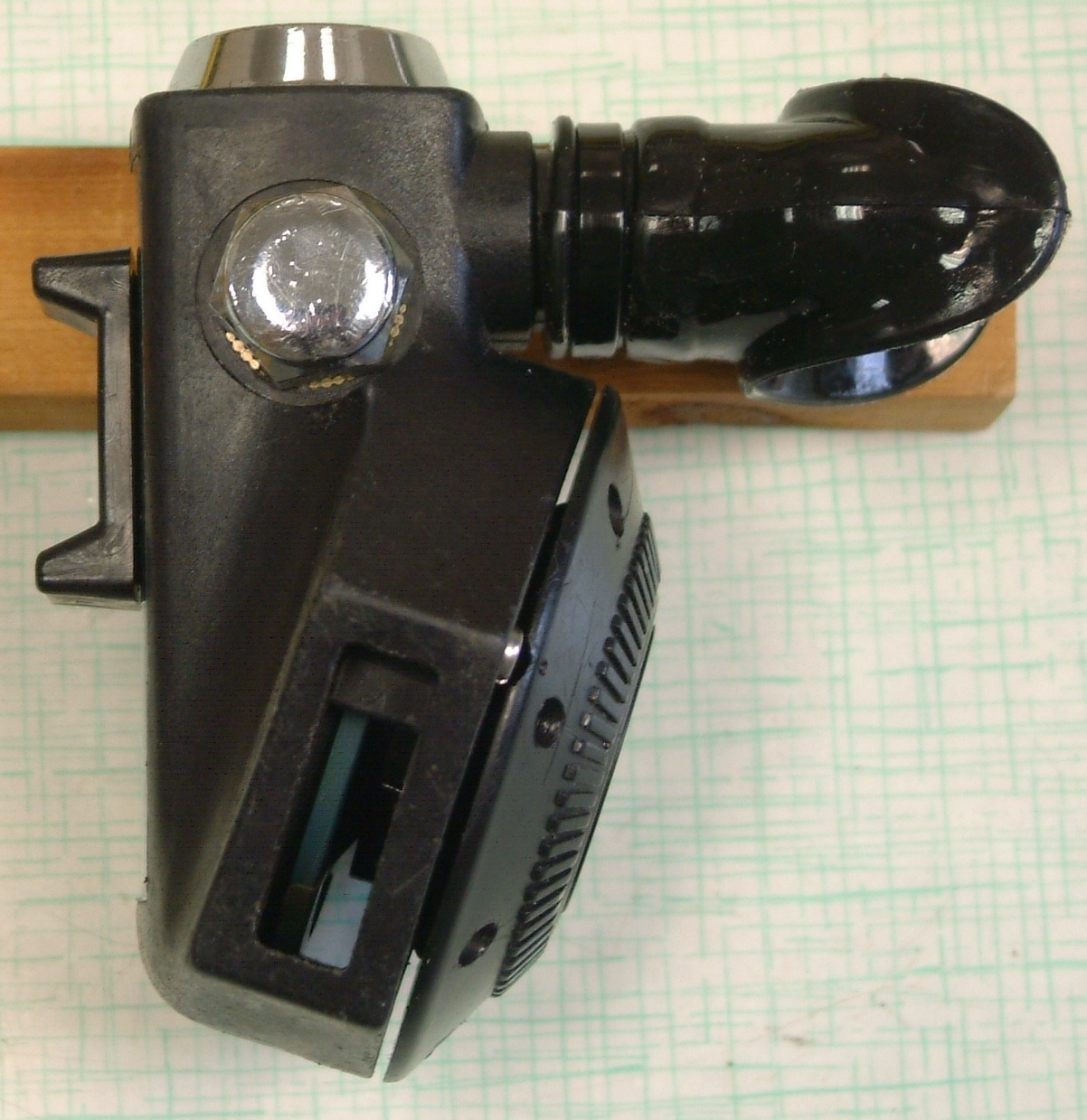altes.tauchen
-> Technik --> Meine Regler
---> Air I ----> Stimmen zum Air I
Testbericht der NEDU zum Pilot
.
 |
ScubaPro museum:
Pilot - This pneumatically amplified second stage offers the
diver the difference between conscious, mechanical breathing and natural automatic
breathing. The regulator was very difficult to maintain and was replaced after only 3
years. The Pilot has a chrome-plated brass body and it could be converted from
right-handed use to a left-hand configuration or double up the second stages. SCUBAPRO
offered a kit that would upgrade the Pilot to an AIR 1.
The Air 1 is the successor to the Pilot using a pneumatic
balanced valve system instead of a pilot valve. It is much less complicated to maintain
than the Pilot yet still provided the ease of breathing that the Pilot offered. It was on
the market from 1979 – 1990. The Air 1 is the first regulator by SCUBAPRO to be made
of a material other than chrome-plated brass. The black fiberglass reinforced material and
shape of the Air 1 earned it the nickname of the “Darth Vader” regulator. The
name stuck and the D300, D350, D400 and the X650 were also nick named the same. You could
also configure this regulator for left-handed use or have a dual regulator set up just as
the Pilot.
The D300, another “Darth Vader” style regulator, was
available from 1986 – 1990. It also uses the same valve as the Air 1. The cover is a
full rubber cover which made the purge valve very easy to access. The D300 had no external
markings to identify it. The Dive/Predive switch was Blue. A red switch button was offered
as an option beginning in 1988 and a teal option was offered beginning in 1990. |
 |
 |
Seastar.at:
Scubapro Air 1 1979
Der Air I hat eine „pneumatisch balancierte, einstellbare Stufe“. Dabei wurde
ein „zentral balanciertes Spulenventil“ verwendet, dass auch unter der
Bezeichnung „coaxiales strömungsbalanciertes Abruf-Ventil“ bekannt ist. Der
Unterschied zum „pneumatisch balancierten einstellbaren Ventil“ ist, dass der
Ventilträger nicht in der Längsrichtung durchbohrt ist, um den Downstream-Druck in einen
ausbalancierten Zustand zu bringen.
Die pneumatische Balancierung wird dadurch erreicht, dass man den Luftdruck auf die zwei
gegenüberliegenden Flächen der „Spule“ wirken lässt, die annähernd die
gleiche Fläche haben. Die Luft tritt in das Ventil in der Mitte des Ventilgehäuses ein.
Die Kraft des Luftdrucks öffnet und schließt den Ventilträger. Um den
Dowstream-Sicherheitsmechanismus aufrecht zu erhalten, ist die Oberfläche an der sich
öffnenden Seite etwas größer als die Fläche an der geschlossenen Seite des
Ventilträgers. Dieser Druckunterschied öffnet das Ventil mit einer Kraft, die gleich der
Differenz der beiden gegengerichteten Kräfte ist. Am oberen Ende des Ventilträgers ist
eine Feder, die die Schließkraft des Ventils verstärkt.
Diese Konstruktion wurde dann im D300, D350 und bis heute im D400 eingesetzt. Sie
ermöglicht eine Bauweise, bei der der Duschknopf unterhalb des Reglers angebracht sein
kann, was strömungstechnisch oft ein Vorteil ist.
Aber auch im Atemkomfort bietet diese Bauweise ein bis heute nicht ausgeschöpftes
Leistungspotential.
 |
 Scubaboard
(von DA Aquamaster): Scubaboard
(von DA Aquamaster):
They were a replacement for the excellent performing Pilot.
The Pilot was superb in terms of performance but was fairly complex and the pilot valve
was very hard to adjust properly. The Air 1 was designed to
offer essentially the same performance (it comes close, at least to sane depths) but with
a much less complex and easier to adjust center balanced valve design. In fact Scubapro
made "upgrade" kits for the Pilot to convert them internally to Air 1's to
reduce their finicky behavior and improve real world reliability. The Pilot was only
around for about 2 years before being replaced by the Air 1 that remained in production
for several years with substantial overlap with D300 and D350
production.
The Pilot and Air 1 oddity is that there is no exhaust valve. Instead the diaphragm lifts
off the case to act as an exhaust valve. This requires a metal clip around about 1/3rd of
the valve as well as an adjustment of the lenght of the pin that connects the diaphragm
and lever.
It works very well and does not produce the leaks on inhalation that you would expect.
There are however 2 potential downsides:
1. It breathes a bit wet given that the diaphragm/exhaust valve is on the upper side of
the case in a face down position (they reversed this in the D300/D350 an D400 that use the
same poppet and center balanced design).
2. Unless the tech is VERY careful, it is fairly easy to poke a hole in the diaphragm with
the metal clip when servicing the reg as the case does not come apart and removing the
diaphragm and clip to service the internals is a bit tricky. This was not a big deal when
it was designed as SP routinely provided new diaphragms at each annual service, however SP
discontinued parts and service support several years ago and new diaphragms are no longer
available.
 If you just bought an Air 1, plug the inlet on the
first stage or remove the second stage and plug the hole in the hose or inlet fitting with
your thumb and try to inhale. If you can draw any air at all there is a good possibility
the diaphragm already has a hole and if so finding a new one will be extremely difficult. If you just bought an Air 1, plug the inlet on the
first stage or remove the second stage and plug the hole in the hose or inlet fitting with
your thumb and try to inhale. If you can draw any air at all there is a good possibility
the diaphragm already has a hole and if so finding a new one will be extremely difficult.
Scubapro has only discontinued parts and service support on three models - the Pilot, the
Air 1, and the first generation Air 2 (the really ugly and clunky looking version of the
Air 2). But given that they no longer provide support, a new diaphragm is not a
possibility. The D300/D350/D400 annual service kits work fine as they sheare the same
poppet. So as long as the diaphragm is good and the large o-ring that seals the purge
cover is in good condition, the reg can usually be returned to service.
My caution here is that many techs have never worked on one (very doubtful that they have
ever done so if they are under 40 years of age and virtually impossible if they have not
been doing reg repair for at least 10 years or so) but a lot of techs would probably like
to work on one to see how they tick. Also, despite any tech interest or ability, some
shops may not encourage it due to the liability issues that may come up from servicing a
reg that was discontinued by Scubapro. When Sp discontinued them, and original owners
would have gotten a free replacement with a comparable performing reg like the D400, G250
or G500 (same with the Pilot and similarly with the 1rst generation Air 2 where a newer
Air 2 would have been provided under warranty). |
altes.tauchen
-> Technik --> Meine Regler ---> AirI ----> Seitenanfang
Letzte Änderung: 16.08.23 |